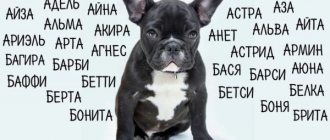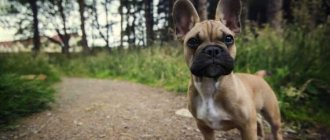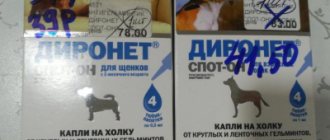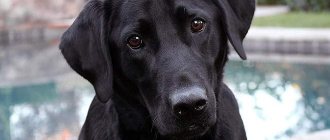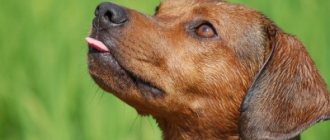Spitz-type and primitive dogs are known to everyone.
Sometimes they are also called aboriginal breeds. These dogs differ from factory dogs in that they were born solely through natural selection in an evolutionary way. Many experts are convinced that the definition of “primitive” is incorrect, but in this context there is a synonym for it: “natural,” which is fully consistent with their origin and subsequent way of life.
The variety of Spitz and primitive aboriginal dogs increases from north to south, exactly in accordance with nature, just as the variety of wild fauna in general increases due south.
Moreover, in their habitat in the polar zone, sled dogs are very similar to each other; in the tundra, their species diversity increases, because Shepherd dogs, hunting huskies, etc. live and work here. And most of the primitive species are in the tropics.
Advantages
These are very healthy dogs that almost do not suffer from genetic diseases typical of factory breeds. Their good health is the result of centuries of natural selection, when the puppy faces a tough choice: survive or die.
These dogs are naturally accustomed to work, which gives them food. They must periodically perform their guard, hunting or riding functions. Otherwise, the breed will deteriorate and the dogs will get sick.
Spitz and primitives are not demanding in terms of living conditions. They can easily withstand severe polar frosts and do not need special food or vitamins to avoid getting sick. Their body works like a clock under the harshest conditions.
Northern Spitz
The habitats of these dogs are located mainly in the north of our planet. Representatives of the following breeds have long hair with a dense, thick undercoat. Since ancient times, these dogs have helped people hunt and herd livestock.
Nordic Spitz dogs include: Finnish Spitz, Swedish Lapphund, Japanese Ainu, Icelandic dog, Japanese Kai, Canadian Inuit dog, Karelian Bear Husky, Japanese Kishu, Japanese Shiba Inu, Norwegian Buhund, Norwegian Lundehund, Japanese Shikoku, Eskimo and Greenland dogs.
General signs
Spitz and primitive dogs are characterized by a dry and lean exterior. Moreover, it is natural, natural, and not cultivated, like greyhounds. Their body is shaped this way by thousands of years of struggle for survival.
Spitz-type and primitive dogs are usually silent. They practically do not bark, but only sometimes grumble. They have well-developed necessary sense organs: vision, hearing and smell, excellent immunity, increased levels of red blood cells in the blood, etc.
These dogs, as a rule, live in packs; within each pack there is its own system of subordination and a leader, to whom Spitz and primitive dogs strictly obey.
All Spitz and primitives have high intelligence, which developed as a result of the constant struggle for their existence, as well as the performance of certain work: hunting, moving cargo in harness, protecting people, material assets, etc.
Mediterranean pointy-eared
These dogs have lived in the Mediterranean region for 5,000 years and were used for hunting, so their hunting instinct is well developed.
They all have a characteristic appearance: long paws, pointed ears and short hair.
At the moment, there are practically no purebred representatives of these breeds left, and most citizens cannot afford the cost of such a dog.
This group also includes: the Maltese Pharaoh Hound, the Sicilian Cirneco dell'Etna, the African Itwina, the Ibizan Hound, the Andalusian and the Portuguese Podenco.
Types of primitive aboriginal dogs
There are a great many of these species; an orderly scientific classification does not exist today. Here are just a few of them:
1) Sled dogs, common in the tundra and polar deserts.
2) Reindeer dogs living in the tundra from Scandinavia to the Far East.
3) Spitz-shaped hunting dogs from Scandinavia, the taiga part of Siberia, China, Japan.
4) Dogs hunting rabbits in the Mediterranean.
5) Fold-eared hunting dogs from North Africa, the Middle East and Central Asia.
6) Dogs guarding livestock throughout Eurasia from Portugal to Mongolia.
Maintenance and care
Particular attention should be paid to wool. Spitz dogs have a very dense undercoat that should be brushed at least once a week. With this care, the Spitz will not shed and cause inconvenience with its shedding hair.
Spitz dogs can and should be trimmed. The frequency depends on the animal and the owner's goals. If the owner decides to seriously engage in participation in exhibitions, visits to the groomer will have to become regular.
Hurry up, choose a box and find out what gift awaits you
Discount on pet insurance
Promo code copied to clipboard
The dog's teeth need to be brushed with a toothpaste specially designed for this purpose several times a month, or better yet, every week. For these procedures, you will need a special brush or attachment that is placed on your finger. Dental bones provide excellent plaque prevention. They remove it while gnawing. Since the Pomeranian is a miniature breed, you should choose the smallest bones.
To trim nails, you will need a nail clipper for toy breeds. After the procedure, treat the sections with a nail file. To prevent paw pads from becoming rough and cracking, rub a mixture of vegetable oils into them, which can be purchased at a specialty store.
The Pomeranian Spitz is an exclusively decorative breed. Although these babies bravely rush at strangers with loud yelps, they cannot be used for protection. Spitz dogs are not intended for living outside the comfortable conditions of an apartment.
If you give them the opportunity to periodically spend time in an open area, for example, in a country house, the owner will need to keep in mind that the Spitz’s natural curiosity knows no bounds: he can easily run away and go in search of adventure.
Spitz dog breeds
These dogs have a strong constitution and harmonious physique, they have tails curved towards the back in the form of a spiral, sharp erect ears and a pointed muzzle. This is the traditional image of a dog.
When purchasing a dog of this breed, you should remember that it is not created for entertainment on sofa cushions. This is a real working dog that needs constant physical activity, otherwise it may get sick.
Today, only in the northern countries: Russia, Finland, Norway, Spitz-type dogs are used as hunting or sled dogs. In warmer regions, they most often become companions or simply decorative dogs.
Canaan dog
This is the only dog that was bred in Israel in the 30s of the last century. In its homeland, it still lives today in a wild or semi-wild form. This is a tall, large dog, similar in appearance to a large Spitz.
The Canaan dog has excellent health, it is capable of being a watchman, serving in the army or police, detaining criminals or searching for drugs. Due to her stable psyche, she is often used as a guide.
Finnish Lapphund
This is a representative of the Arctic Spitz-type dogs, capable of herding herds of deer. The Finnish Lapphund has absolutely no hunting instinct, and also cannot perform the functions of a watchman.
Today, these dogs are most often used as companions, they love to perform in dog sports competitions, at exhibitions, and are suitable for search and rescue service. This Lapphund is one of the most popular breeds in Finland.
Italian Volpino
This Spitz comes from Florence. It is also called the palace dog. His ancestor was a Spitz who lived in Europe during the Bronze Age. "Volpino" means "fox" in Italian. The history of the breed begins in 1901.
The dog has a small and harmonious build, has a beautiful raised white coat. She has a cheerful character, is very smart, loves to play, especially with children. A wonderful companion.
Nenets Laika
This husky retained all the features of primitive dogs that formed in the European tundra after the Ice Age. It is widely used for deer herding and hunting. Experts consider it to be the closest relative of the German Spitz.
The Nenets Laika has a strong and light build, a balanced psyche, and can be a partner on polar expeditions and just a family friend. This is a very hardy and healthy dog that performs a given job only “excellently”.
German Spitz
These dogs are direct descendants of European turf dogs that lived in Europe during the Stone Age. The German Spitz is considered the oldest breed on the continent and is the origin of many other breeds of modern and extinct dogs.
Like all Spitz dogs, this breed has an excellent build with a well-developed chest. They can have a variety of thick coat colors. The dog has a calm, balanced character and can be kept in a city apartment.
Chow chow
This is one of the oldest breeds of guard dogs; its name is translated from Chinese as “shaggy lion.” She really looks like a lion, only a small one. Belongs to the category of Spitz-type dogs.
Chow chows have been known in China for at least 2 thousand years. In ancient times, they were used for hunting, to guard herds of deer, and even as sled dogs. This breed was bred in Buddhist monasteries. Today, Chow Chows are popular toy dogs.
Yamthund
This is a large Swedish husky, also a Spitz-type dog. It is intended for moose hunting. An independent breed appeared in the middle of the 20th century; these dogs are very similar to their Norwegian counterparts, but larger than them.
In the old days, the Yamthund also hunted bears and lynxes. He can perform the duties of a herding, guard or sled dog. In Sweden, the Yamthunda is sometimes used in military and police service.
Siberian Husky
This aboriginal dog is one of the oldest breeds on earth and a distant relative of the Spitz. It is used as a sled dog and is also popular among Russians as a companion.
The Siberian Husky is medium-sized and can be kept in an apartment, but must be walked outside the city every day. There are many clubs for Siberian Husky lovers in Russia, where harness competitions are held between these sled dogs.
Alaskan Malamute
Another powerful aboriginal sled dog, which is one of the symbols of Alaska. Malamutes, like all Spitz-type dogs, descended from wolves. This is a working breed that still regularly performs its duties in the harness.
Peculiarity of the breed: Malamutes hardly bark, like their ancestors, wolves. This is a very hardy dog that can survive many hardships. She has a high level of intelligence, but she needs to be educated from early childhood.
Akita Inu
This Spitz-like breed was developed in Japan. Hundreds of years ago, these dogs were taken to hunt large animals, incl. on the bear. Archaeological excavations have shown that such dogs have existed in Japan for more than 2 thousand years.
Akita has beautiful thick and fluffy fur, most often with a red color. You can keep her both in an apartment and in an outdoor enclosure; she is unpretentious. The Japanese consider the Akita Inu to be a real treasure of Japan.
Samoyed husky
This is a northern aboriginal sled dog, descended from the Nenets Laika. Currently, there are several standards for this breed. The Samoyed is medium in size, but has remarkable strength. Knows how to smile.
The Samoyed dog has a self-sufficient and independent character. She is very smart and friendly. However, it should not be kept at home - it will run away and wander. Requires as many walks and sports as possible.
Thai Ridgeback
This is one of the oldest breeds of aboriginal primitive dogs and the national symbol of Thailand. Place of origin: Southeast Asia. Ridgeback knows how to catch rabbits and other small animals, so he was a breadwinner for the poorest segments of the population.
In addition, he is an excellent guard and companion for his owner and his family. Like all primitive dogs, the Ridgeback does not impose itself on a person and keeps its distance. He has high intelligence and excellent intuition, is very clean, and does not smell like a dog.
Besenji
This is one of the oldest breeds originating from Africa; experts believe that it is at least 5,000 years old. Besenjis cannot bark, do not smell like dogs, and wash themselves with their paws, like cats, with whom they get along well.
In Ancient Egypt, they were mummified and buried along with their owners, the pharaohs. In some African countries this dog is still used for hunting. In Europe and North America, besenjis are purchased as companions.
Share on social media networks
Greyhounds
African Azawakh, Afghan, Arabian Servant, Greek Greyhound and Iranian Saluki.
These dogs were used not for searching, but for driving game, so their sense of smell is not particularly developed. But they can develop enormous speed.
Of course, there are other indigenous breeds (for example, there are over a dozen of them in the former USSR), but their history is not as ancient as the history of representatives of these four groups.
Editorial opinion may not reflect the views of the author.
Did you like the article? Tell your friends about it!
Spitz-type and primitive dogs are known to everyone. Sometimes they are also called aboriginal breeds. These dogs differ from factory dogs in that they were born solely through natural selection in an evolutionary way.
Many experts are convinced that the definition of “primitive” is incorrect, but in this context there is a synonym for it: “natural,” which is fully consistent with their origin and subsequent way of life.
The variety of Spitz and primitive aboriginal dogs increases from north to south, exactly in accordance with nature, just as the variety of wild fauna in general increases due south.
Moreover, in their habitat in the polar zone, sled dogs are very similar to each other; in the tundra, their species diversity increases, because Shepherd dogs, hunting huskies, etc. live and work here. And most of the primitive species are in the tropics.
Pomeranian Spitz price
It’s worth noting right away that the Pomeranian is not a cheap dog breed. And if someone offers you a puppy for a couple of thousand rubles, then most likely he is not a purebred or suffers from some kind of disease.
The cost of puppies depends on the rarity of color and blood. If there were champions in the dog’s family, then it will cost quite a lot. On average, a purebred Pomeranian puppy with the necessary documents that meets all standards will cost about 20 thousand rubles. For a show-class animal they can ask for several thousand dollars.
How to choose a puppy?
Before you choose a Pomeranian puppy, you need to understand why you need one. If just for love and company, then a pet-class baby will suit you. It is not that expensive, but has all the qualities and good looks of a Pomeranian. But this option is not suitable for exhibitions. For this you need a show class dog. Its price will be much higher. Well, if you plan to start breeding this breed, then you will need a breed-class dog.
The future owner must understand that this or that class cannot guarantee that the puppy will become a super champion or that the animal will give a good litter. In order not to make a mistake with your choice, you need to purchase a puppy from experienced breeders or well-known nurseries. In fact, any puppy, even pet class, can become a champion. The main thing is to pay due attention to the care, health and training of the baby. Of course, the dog must fully comply with the breed standard.
To choose a good puppy, pay attention to his health and how he looks. A dog that is healthy will be cheerful, playful and interested in interacting with you. He should not be afraid of a hand extended to him. The size depends on what kind of dog you need. If miniature, then give preference to the smallest puppies.
A dog's future behavior is greatly influenced by its gender. If you choose a male dog, you will have to be prepared for the fact that they are more aggressive and stubborn than females. Girls are distinguished by their flexible and gentle disposition. Although, of course, there are exceptions.
